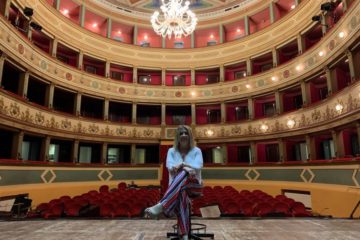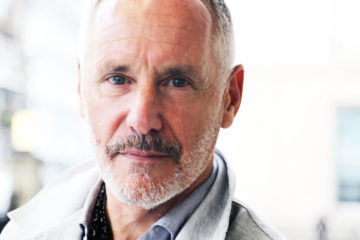There’s no doubt about it – it’s a great time of year for lovers of contemporary opera! One of the world’s greatest producers of contemporary opera, Beth Morrison Projects, has chosen to stage two 30-minute dramas, one by Emma O’Halloran and another by Michael Lanci, two of the brightest young up-and-comers in the opera scene. I am beyond thrilled to have had the opportunity to talk to both composers, as well as the director of both stagings, Jennifer Williams, about the pieces and their individual creative processes.
A quick note: in the responses below, “BM” denotes Beth Morrison, “EO” Emma O’Halloran, “ML” Michael Lanci, and “JW” Jennifer Williams.
Tell us about putting on a production for Beth Morrison Projects: Next Generation; how does casting work? What are the budget limitations? Who builds the set? Where do rehearsals take place? How many full run throughs are there?
BM: Beth Morrison Projects produces work in different ways and at different scales depending on the needs of the work and the intention of the project at hand. The resources devoted to a fully produced world premiere opera or music-theatre project are significant and turn out the likes of Dog Days (David T. Little and Royce Vavrek), p r i s m (Ellen Reid and Roxie Perkins), anatomy theater (David Lang), Aging Magician (Paola Prestini), and Acquanetta (Michael Gordon) among many others. BMP: Next Generation requires a different level of resources for each phase of the program. In year one, we featured 10 composers in concert with 5-10 minute vocal works. There were no physical production elements in the form of sets or costumes, but there was minimal projection and video design as well as lighting. For year two, the presentation of two work-in-progress operas by Michael Lanci/Ajax Axe and Emma O’Halloran, there will be minimal costumes and props that are suggestive of the world, touches of projection and video design, no scenics, and lighting with light staging by our director Jennifer Williams. Performers will not be memorized. For the full-evening opera commission which will be determined at the end of performance 2 (February 21), we will use full company resources to create the aesthetic and level of polished production work that we require for all BMP productions. As these are works in progress, the rehearsal period is condensed with most of the focus on music rehearsals.

To help our readers get some background on your work, if you had to do an elevator pitch for Mary Motorhead, what would you say?
EO: Mary Motorhead is a monodrama about a woman serving an eighteen-year sentence in an Irish prison for a violent crime. History is invention, she tells us, a made-up story based on sometimes scant knowledge of the available facts. Each of us has a known history and a secret one. Our secret history is the history that really happened – the one going on inside – something that regular history, or reportage, can never really know. So, Mary invites us to hear her secret history – the disappointments and betrayals that shaped her life in the Irish midlands – in the hope that it may shine some light upon the darkness of her actions.
I have the same question about Crude Capital: what’s the elevator pitch?
ML: Set in 2028, during a hurricane that levels an unnamed southern city, Crude Capital follows the crisis of conscience of congresswoman, Grace Hennessy, as she realizes the policies she’s been paid to support have led to the city’s destruction. As she grows increasingly vocal about the problem of climate change, her political backers, Denis Krude and members of The Coal and Cattle Club of America turn against her and plot to discredit and remove her from office. Darkly satirical with hints of magical realism, Crude Capital is an opera about the dangers of super PAC money within American Politics and how a small group of billionaires are destroying American democracy in pursuit of ever larger fortunes.

Did you both write your own librettos?
EO: For the libretto, I adapted a play written by my uncle, Mark O’Halloran, and a lot of the text comes directly from the original work. Mark uses some fantastic imagery and language in his writing, and I wanted to stay as true to it as possible.
ML: I did not write the libretto for Crude Capital, but did have the pleasure of collaborating with my childhood friend and very talented writer and sculptor, Ajax Philips, on the initial conception of this opera. After many lengthy conversations about the theatrical world we wanted to create, social and political topics to be addressed, and the overall character of the opera, I left her alone to realize her vision, and I couldn’t be more excited with what she created.
I’m interested in your individual creative processes. From where did the inspiration for Mary Motorhead and Crude Capital come? Did you start with a theme you wanted to explore? Did you start with a musical idea? Walk us through that fascinating process.
ML: Since this is my first opera, my musical process was quite different then how I approach a purely instrumental composition. I wanted to explore the emotional and psychological journey of the two main characters and the rather turbulent evolution of their relationship with one another. This fascination compelled me to dive headfirst into writing their Arias before any other musical sketches were fully realized. Approaching the creative process from this angle provided me with the melodic themes, rhythmic motifs and larger musical atmospheres that would serve as the musical fabric to be woven throughout the operas five scenes.
EO: When I set out to write this piece, I spent a lot of time thinking about place. I wanted the music to convey the isolation of solitary confinement and yet also suggest the expanse of Mary’s vivid imagination, a flight of mind that lets her travel outside her jail cell. In general, I began with sounds that suggested a certain place and I developed my musical material around this. For the opening of the piece I created some reverberant electronic percussion that suggests the bleak echoes of empty prison corridors. I was also interested in capturing the industrial landscape in which she grew up, so I began developing sounds of electrical interference that eventually ‘infect’ the instruments in the ensemble.
I’m also interested to know what it’s like directing world premiers; there’s no performance history to rely on and the audience is completely in the dark with regard to what they’re about to experience.

JW: Even when the story and music are new, audiences often bring certain expectations and associations with opera more generally – and a world premiere can be an opportunity to upend those expectations. The power of new work is in its immediacy, and in directing a world premiere I want to find ways to harness that immediacy so that it resonates at every level of the performance. This often means looking to alternative modes of storytelling to find the expressive vocabulary that best serves the story. Immersive theater, site-specific performance, video design, Viewpoints, and circus are all techniques I have used in my past work. While the performance history of a new work begins with its premiere, a new work is still part of the fabric of performance history more broadly and allows both artists and audiences to enter an ongoing conversation about music theater’s history and to draw connections between different musical and dramatic traditions.
In the composer-director relationship, do your artistic visions ever clash?
JW: I haven’t had that experience personally. A director’s job is to tell the story, and we serve the story and the audience. Most composers with whom I have collaborated would say the same about composing. A vision only becomes a reality through collaboration – and to my mind collaboration is the bedrock of a director’s work. In working with composers and librettists – as well as singers, designers and all artists with whom I work – I catalyze our collaboration through questions and push the group to pursue each question to the end of its thread together. Music and theater are an inquiry into the human condition, and the best creative processes share that spirit of inquiry.
Let’s talk about the music in your monodramas. One of the most rewarding things for me when I study an opera is finding the “messages” sprinkled throughout the score that add to the drama. Can you give us any examples of that kind of thing, where the music “says” more than what we’re seeing on stage or hearing through the text?
EO: Absolutely! Playing with hidden messages and subtext was very important for me in this piece because the story is about the friction between how we perceive things and what lies beneath. One element that I’m particularly excited about is that I have incorporated samples of several pop songs that relate to certain moments in Mary’s life, but when we hear them they are unrecognizable. I was thinking a lot about the feelings that are evoked by hearing something familiar in a strange context, and using fragments of these songs allowed me to create this uncanny atmosphere of both nostalgia and loneliness which I thought was perfect for Mary’s story.
Can audiences expect arias? Recitatives? Spoken dialogue? Big orchestras? Electronic sounds? Supertitles?
EO: Yes! Arias, electronic sounds, and some electric guitar!
ML: Except for supertitles, the audience can most certainly expect all of the above. Much of the opera is focused on sung text, ranging from arias to a quartet in the final scene. There are moments of recitative and a rather twisted radio interview that mainly features very animated spoken text interrupted by outbursts of song.
Can you give the world premiere audience any hints? Is there anything you want to make sure the first audience absolutely understands?
ML: After reading Jane Mayer’s incredible book Dark Money, Ajax and I felt that we needed to create an opera that functioned as a proverbial mirror on contemporary society, allowing the audience to reflect on the larger sociopolitical, humanitarian, and environmental issues that make up our current reality. We wanted Crude Capital to serve as a commentary on the current state of dark money within American politics and a broader view of the human condition and our tenuous relationship to wealth, power and the environment.
EO: As much as this piece revolves around how we perceive things versus how they truly are, it is also about the stories that we tell ourselves. I think it’s important to understand that Mary isn’t speaking to the audience when she’s telling her story, she’s speaking to a version of herself.
JW: The complexity of the characters. What I love about both works is that no character is one-sided: the villains reveal their human sides, and the heroes wrestle with their flaws. Both stories delve into a dynamic and multifaceted exploration of the human condition in this way.


